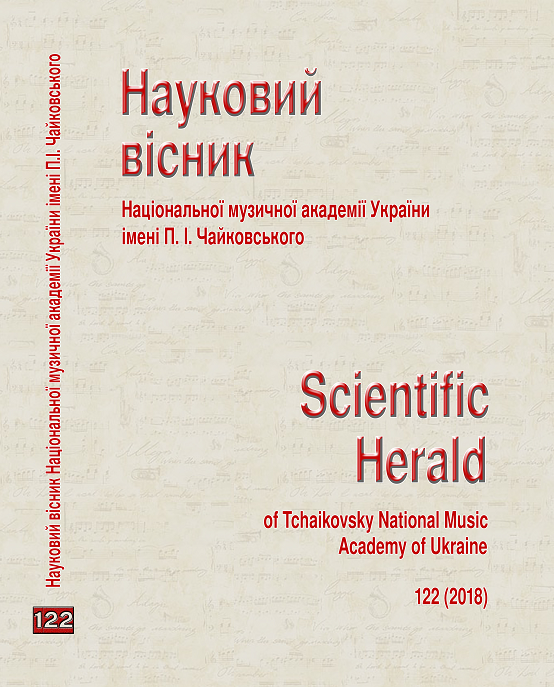The phenomenon of "spatial music" in the instrumental works of Edgard Varèse
DOI:
https://doi.org/10.31318/2522-4190.2018.122.141858Keywords:
spatiality, "spatial music", music of the twentieth century, creativity of Edgard Varèse, instrumental music, composition technique, timbreAbstract
Relevance of the study. Edgard Varèse's creativity is important in the context of the development of the twentieth century music. His creative concept of "spatial music" influenced many composers of the second half of the twentieth century and the development of electronic music in particular. However, it remains little investigated in the composer’s instrumental works. The main objective of the study is to demonstrate ways of embodying the concept of "spatial music" by Edgard Varèse in his instrumental works and to identify their connection with the general regularities of spatial perception and thinking in music.
Methodology of research: the method of musicological analysis for the study of Edgard Varèse's work, methods of deduction and induction, generalization, analogy, historical approach. Main results and conclusions of the study. The implementation of the concept of "spatial music" by Edgard Varèse is based on the expansion of timbre in combination with the detailing and variety of musical dynamics. It corresponds to the depth parameter in music. Varèse makes it possible to perceive a separate sound or concord as an independent unit that exists separately in the musical space and can be a constructive element of the whole. It can be called the development or expansion of subject musical representations, which underlie perception of music and musical thinking in general. Musical-spatial representations, which in the classical approach were limited to the domination of the vertical and horizontal, composer changes due to a significant increase in the role of depth. This way of creating space in music differs from the acoustic, which Varèse could only realize in the electronic composition of 1958 at the expense of the corresponding technical means, appeared later than written his main instrumental works.
The significance of the results is to fill the "white spot" in studies related to a significant figure in the music of the twentieth century by composer Edgard Varèse. It is also important to deepen scientific ideas about musical space and the concept of "spatial music" owing to the application of theoretical developments of various authors to the material of the composer's work of the beginning of the last century. This enables the new level to understand the processes of change that have taken place on the verge of centuries and have led to a radical update of musical expression and composition techniques over the next few decades.
Downloads
References
Aranovskiy, M. (1974), “About Psychological Preconditions of Object-spatial Auditory Representations”, in: Aranovskiy M., ed., Problemyi muzyikalnogo myishleniya [Problems of Musical Thinking], Muzyika, Moscow, pp. 252-271 [in Russian].
Varèse, E. (2009), “The Liberation of Sound”. Translated by A. Maklyigina. In: Kyugeryan T., Tsenova V., ed., Kompozitoryi o sovremennoy kompozitsii [Composers about contemporary composition], Nauchno-izdatelskiy tsentr «Moskovskaya konservatoriya», Moscow, pp. 7-71 [in Russian].
Kunitskaya, R. (1990), French Composers of the Twentieth Century : Essays, Sovetskiy kompozitor, Moscow, 208 p. [in Russian].
Manulkina, O. (2010), From Ives to Adams: American Music of the Twentieth Century, Izdatelstvo Ivana Limbaha, Saint Petersburg, 784 p. [in Russian].
Nazaykinskiy, E. (1972), About the Psychology of Musical Perception, Muzyika, Moscow, 384 p. [in Russian].
Sigida, S. (2012), Musical Culture of the United States of the Late XVIII - First Half of the Twentieth Century. Formation of National Identity. Essays, Kompozitor, Moscow, 504 p. [in Russian].
Tukova, I. (2011), “The Treatment of Sound as a Factor in the Formation of Musical Composition Techniques”, Chasopys Nacionaljnoji muzychnoji akademiji Ukrajiny imeni P. I. Chajkovsjkogho [Journal of Tchaikovsky National Music Academy of Ukraine], vol. 1(10), pp. 72-79 [in Ukrainian].
Tukova, I. (2011), “About Sonorous Space”, Kyyivske muzykoznavstvo [Kyiv musicology], vol. 37, pp. 64-88 [in Russian].
Holopova, V. (2000), Music as an Art Form, Izdatelstvo «Lan», Saint Petersburg, 320 p. [in Russian].
Holopov, Yu. (2003) New paradigms of musical aesthetics of the twentieth century, available at: http://www.kholopov.ru/prdgm.html (accessed 18 January 2018) [in Russian].
Downloads
Published
How to Cite
Issue
Section
License
Our journal abides by the CREATIVE COMMONS copyright rights and permissions for open access journals.
Authors, who are published in this journal, agree to the following conditions:
The authors reserve the right to authorship of the work and pass the first publication right of this work to the journal under the terms of a Creative Commons Attribution License, which allows others to freely distribute the published research with the obligatory reference to the authors of the original work and the first publication of the work in this journal.
The authors have the right to conclude separate supplement agreements that relate to non-exclusive work distribution in the form in which it has been published by the journal (for example, to upload the work to the online storage of the journal or publish it as part of a monograph), provided that the reference to the first publication of the work in this journal is included.




